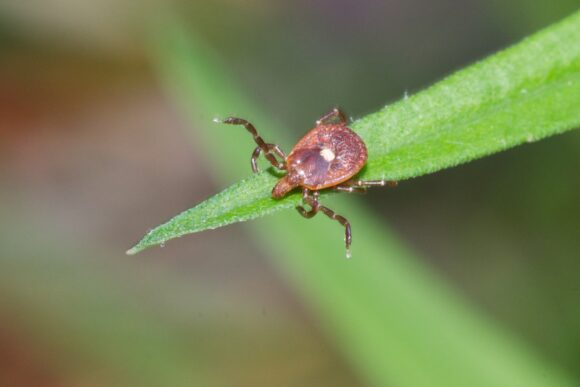
Lone Star Tick. Photo: Jim Occi, Center for Vector Biology.
A recent report in the Journal of Medical Entomology has important public health implications for New Jersey, which only recently joined a select number of states to discover an emerging virus in populations of the lone star tick (Amblyomma americanum L.). The report was co-authored by Dana Price and Nicole Wagner from the Dept. of Entomology, and Andrea Egizi and Robert Jordan from the Monmouth County Tick-borne Disease Program.
Bourbon virus (BRBV) is a human pathogen that was first isolated from a symptomatic individual in Bourbon County, Kansas, who subsequently died of the illness. Since that time, human cases have been confirmed in Kansas, Missouri, and Oklahoma.
The virus is likely to be transmitted to humans via the bite of the lone star tick and was very recently detected in a survey of these ticks in New York state. To assess the potential presence and abundance of BRBV in New Jersey lone star ticks, researchers from the Rutgers University Center for Vector Biology and Monmouth County Tick-borne Disease Program screened over 1,200 specimens and detected BRBV in three individual ticks, while also generating a complete genome sequence of the virus from a single infected tick.
Lone star ticks will readily feed on deer, and researchers in New York state found that greater than 60% of deer from many Long Island sites had been exposed to the virus. Exactly how so many deer were exposed, and whether ticks were ultimately responsible for transmission remains an unanswered question. We don’t yet have such data for New Jersey, but it will be an important aspect in determining what influences local Bourbon virus cycles.
It is important to note that only five human cases of BRBV have been confirmed in the U.S., and a very small fraction of ticks have tested positive in both New York and New Jersey. The likelihood of encountering an infected tick thus appears to remain exceedingly low. However, this virus is only one of several tick-borne pathogens that are increasing their known range and/or abundance throughout the Northeastern United States.
Residents are always encouraged to follow CDC guidelines for reducing tick bites during and after outdoor activities. New Jersey residents exposed to ticks can submit them to our citizen science project, NJ Ticks 4 Science and contribute to our understanding of human-tick exposures.
Read about the research in the abstract appearing in the Journal of Medical Entomology.

